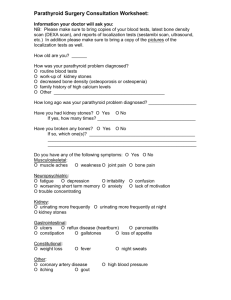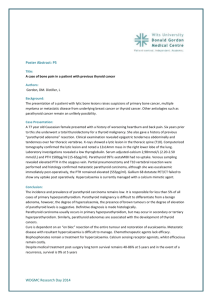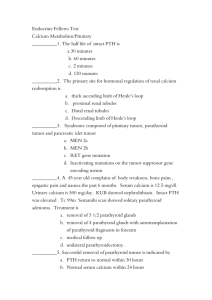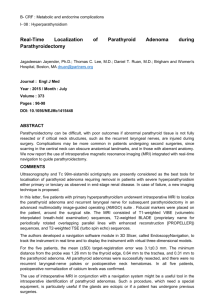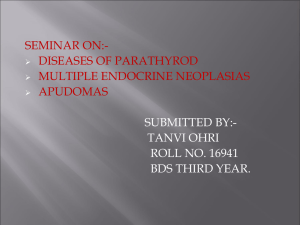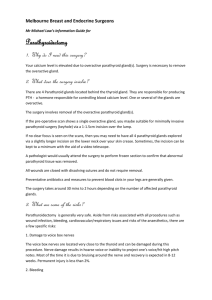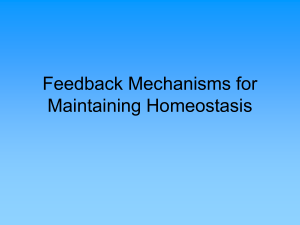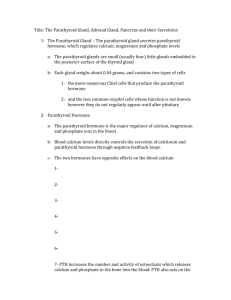166_MLP_ENG
advertisement
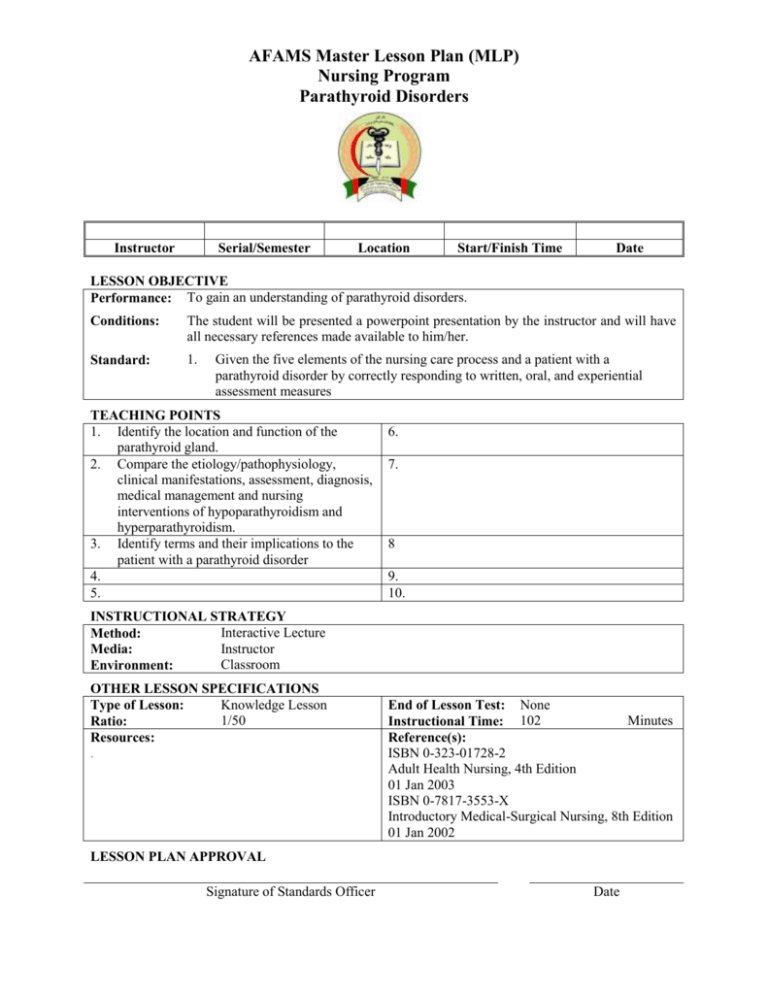
AFAMS Master Lesson Plan (MLP) Nursing Program Parathyroid Disorders Instructor Serial/Semester Location Start/Finish Time Date LESSON OBJECTIVE Performance: To gain an understanding of parathyroid disorders. Conditions: The student will be presented a powerpoint presentation by the instructor and will have all necessary references made available to him/her. Standard: 1. Given the five elements of the nursing care process and a patient with a parathyroid disorder by correctly responding to written, oral, and experiential assessment measures TEACHING POINTS 1. Identify the location and function of the parathyroid gland. 2. Compare the etiology/pathophysiology, clinical manifestations, assessment, diagnosis, medical management and nursing interventions of hypoparathyroidism and hyperparathyroidism. 3. Identify terms and their implications to the patient with a parathyroid disorder 4. 5. 6. 7. 8 9. 10. INSTRUCTIONAL STRATEGY Interactive Lecture Method: Instructor Media: Classroom Environment: OTHER LESSON SPECIFICATIONS Knowledge Lesson Type of Lesson: 1/50 Ratio: Resources: . End of Lesson Test: None Minutes Instructional Time: 102 Reference(s): ISBN 0-323-01728-2 Adult Health Nursing, 4th Edition 01 Jan 2003 ISBN 0-7817-3553-X Introductory Medical-Surgical Nursing, 8th Edition 01 Jan 2002 LESSON PLAN APPROVAL Signature of Standards Officer Date AFAMS Master Lesson Plan (MLP) Nursing Program Parathyroid Disorders INTRODUCTION Allocated Time: Review: 5 Minutes You have had previous anatomy and physiology lectures in your combat medic training, this lecture will build upon prior instruction. Objective: To discuss/describe topics related to the nursing process. Importance: Nurses work in various health care settings so it is important to gain an understanding of this subject as it will apply to your clinical practice. Fit: Although the parathyroid glands are tiny epithelial masses, they play an important role in blood homeostasis. The parathyroid glands secrete parathyroid hormone. Its chief function is to help maintain homeostasis of blood calcium concentration by promoting calcium absorption into the blood. The maintenance of calcium homeostasis in the blood is important for healthy survival. Normal neuromuscular irritability, blood clotting and cell membrane permeability all depend on the blood concentration of calcium maintained within normal levels. Approach: You will be presented the subject in lecture format and will be tested using a written exam at a later date. Control Statement: If you have any questions during the lesson please feel free to ask. BODY 1. Teaching Point: Identify the location and function of the parathyroid gland. Minutes Allocated Time: Introduction: Learner Participation: Knowledge Lesson Please follow along with your hand outs and take notes. Skill Lesson Powerpoint presentation with associated handouts. Learning Support: a. Parathyroid Glands (1) Location: Four glands located on the posterior surface of the thyroid gland (2) Function (a) Secrete parathyroid hormone (parathormone) (b) Increases the concentration of calcium and regulates the amount of phosphorus in the blood (Antagonist to calcitonin released by thyroid gland) (c) Release increases reabsorption of calcium and magnesium from kidney tubules and increases elimination of phosphorous by kidneys 1 AFAMS Master Lesson Plan (MLP) Nursing Program Parathyroid Disorders Knowledge Lesson: Question: Answer: Check on Learning In a knowledge lesson, pose questions to the class. What is a function of the parathyroid gland? Secrete parathormone which increases the concentration of calcium and regulates the amount of phosphorous in the blood. Skill Lesson: In a skill lesson, provide practice and watch students perform a skill. 2. Teaching Point: Compare the etiology/pathophysiology, clinical manifestations, assessment, diagnosis, medical management and nursing interventions of hypoparathyroidism and hyperparathyroidism. Minutes Allocated Time: Introduction: Learner Participation: Knowledge Lesson Please follow along with your hand outs and take notes. Skill Lesson Powerpoint presentation with associated handouts. Learning Support: a. Hypoparathyroidism (1) Etiology/pathophysiology (a) Decreased parathyroid hormone release, resulting in decreased levels of serum calcium (b) Idiopathic form of this disorder is a rare condition (c) Inadvertent removal or destruction of one or more of the tiny parathyroid glands during thyroidectomy is the most common cause (2) Clinical manifestations (a) Hypocalcemia, hyperphosphatemia 1) Neuromuscular hyperexcitability 2) Involuntary and uncontrollable muscle spasms 3) Hypocalcemic tetany (b) Severe hypocalcemia 1) Laryngeal spasm, stridor, cyanosis with increased risk of asphyxia 2) Calcification of the basal ganglia in the brain, causing Parkinson-like bizarre posturing and spastic movements (3) Assessment 2 AFAMS Master Lesson Plan (MLP) Nursing Program Parathyroid Disorders (a) Subjective 1) Complaint of dysphagia 2) Complaint of numbness and tingling 3) Anxiety, irritability, depression 4) Headaches, nausea 5) Kidney stone formation due to increased renal excretion (b) Objective 1) Positive Chvostek's sign 2) Positive Trousseau's sign 3) Laryngeal spasm/stridor 4) Decreased cardiac output (hypotension, decreased peripheral pulses, changes in LOC) 5) Spasms of the extremities, general muscular hypertonia - voluntary movement may be followed by an involuntary, jerking spasm 6) Cardiac dysrhythmias 7) Muscle cramping may be present 8) Generalized convulsions 9) Nausea, vomiting, and abdominal cramps (4) Diagnostic evaluation (a) Hypocalcemia (serum), increased urinary calcium 1) Must rule out other causes of hypocalcemia - vitamin D deficiency, kidney failure, and acute pancreatitis (b) Hyperphosphatemia (serum), decreased urinary phosphorous (c) Recognition of hypoparathyroid tetany as may be seen after a thyroidectomy (5) Medical management (a) Intravenous calcium gluconate or calcium chloride 1) Very irritating to vessel walls - give at a rate not to exceed 1ml/min 3 AFAMS Master Lesson Plan (MLP) Nursing Program Parathyroid Disorders 2) If given too rapidly, may precipitate cardiac arrest 3) Avoid extravasation, as sloughing can occur 4) After initial bolus, may maintain slow IV infusion until tetany resolves 5) Side effects: nausea, vomiting, lethargy, muscle weakness (signs of hypercalcemia) (b) Vitamin D - given orally to increase the absorption and maintain serum levels of calcium 1) Long-term treatment following trauma to or inadvertent removal of the parathyroids includes administration of Vitamin D or Vitamin D2 (calciferol), which increases the blood level of calcium (c) Bronchodilators may be ordered (d) Endotracheal intubation and mechanical ventilation may be necessary (if acute respiratory distress occurs) (e) A diet high in calcium and low in phosphorus is usually recommended (6) Nursing interventions (a) Monitor for signs/symptoms of hypocalcemia 1) Arms and legs are examined for evidence of muscular tetany 2) If tetany is suspected, check for positive Chvostek's sign 3) Monitor heart rate and rhythm (b) An emergency tracheostomy tray, airways, mechanical ventilation, and endotracheal intubation equipment should be kept at the bedside if the patient has severe hypocalcemia (due to possibility of laryngeal spasms) (c) After surgery on the thyroid gland, the client is observed for signs and symptoms of hypoparathyroidism (d) Monitor for signs of hypercalcemia with IV replacement therapy 1) Disorientation, weakness 2) Vomiting, anorexia, abdominal pain 3) Bradycardia, syncope and hypotension 4) Use cautiously with patients receiving Digitalis, as it may precipitate Dig toxicity 5) Use Tagamet carefully as it interferes with parathyroid function (e) Teach/assess understanding of medication and dietary regimen 4 AFAMS Master Lesson Plan (MLP) Nursing Program Parathyroid Disorders 1) Frequent monitoring of serum calcium and phosphorous levels 2) Importance of calcium supplements 3) Diet high in calcium: dairy products, dark green vegetable, soy beans and canned fish with bones included (f) Teach/assess understanding of signs/symptoms of hypocalcemia and need to contact physician (7) Prognosis - a fairly normal lifestyle and life expectancy are possible NURSING DIAGNOSIS Risk for injury, related to postoperative hypocalcemia OUTCOME Patient will maintain electrolyte status within normal limits Pain, related to disease process (skeletal, joint, renal colic) Patient will verbalize acceptable pain control NURSING INTERVENTIONS 1) Teach/assess understanding of signs/symptoms of hypocalcemia 2) Initiate replacement therapy as needed 1) Assess factors that worsen/improve pain 2) Help patient adjust body mechanics or activity 3) Encourage adequate fluid intake 4) Provide non-pharmacologic comfort measures 5) Provide analgesics and monitor effect b. Hyperparathyroidism (1) Etiology/pathophysiology (a) Overproduction of parathyroid hormone (parathormone) (b) Increased urinary excretion of phosphorus (c) Bones become demineralized as calcium leaves and enters the bloodstream (d) Large amounts of calcium and phosphorus passing through the kidneys may lead to stones, pyelonephritis, and uremia; renal disease may occur (e) Common causes 1) Hypertrophied gland tissue and tumors (adenoma) 2) Chronic renal failure 3) Pyelonephritis/glomerulonephritis 5 AFAMS Master Lesson Plan (MLP) Nursing Program Parathyroid Disorders 4) Carcinoma is rare with rapid progress and a poor prognosis (f) Afflicts women twice as often as men, and usually occurs between 30 and 70 years of age (2) Clinical manifestations (a) Hypercalcemia as calcium leaves the bone and accumulates in the bloodstream (b) Skeletal pain, pain on weight bearing, and pathological fractures (c) Kidney stone formation (3) Assessment (a) Subjective 1) Assessment of severity of pain 2) Degree of muscle weakness 3) Complaints of fatigue, drowsiness, apathy 4) Complaints of nausea, constipation 5) Personality changes, disorientation and paranoia (b) Objective 1) Observation for skeletal deformity or abnormal bone movement (may indicate pathological fractures) 2) Monitor urine for quantity, hematuria and stones 3) Vomiting, weight loss 4) Hypertension and cardiac dysrhythmias 5) Bradycardia 6) Decreased level of consciousness, stupor or coma (4) Diagnostic evaluation (a) Hypercalcemia and hypophosphatemia (b) Increased blood parathyroid hormone levels (PTH) and alkaline phosphatase (c) 24 hour urine shows increased urine calcium levels (d) Skeletal X-rays may reveal skeletal decalcification (loss of calcium from bones) 6 AFAMS Master Lesson Plan (MLP) Nursing Program Parathyroid Disorders (e) MRI or CT of parathyroid glands to identify parathyroid adenoma (5) Medical management (a) Removal of hypertrophied gland tissue or of an individual tumor (b) Observe for signs and symptoms of hypoparathyroidism (c) Post-op management similar to that of patient with thyroidectomy (6) Nursing interventions (a) Maintain fluid and electrolyte balance 1) Strict I&O - strain all urine 2) Diuretics may be used to lower serum calcium and avoidance of fluid volume excess a) Lasix is the drug of choice 1 Diuretic to manage fluid retention and decreased urine output as a result of parathyroid surgery 2 Side effects: headache, fatigue, tinnitus, orthostatic hypotension and polyuria 3 Daily labs - report abnormal values 4 Maintain low calcium diet 5 Promote acid-ash fluids (i.e., cranberry juice) to prevent stone formation (acidify urine) 6 Assess for signs of hypocalcemia a Tetany b Cardiac dysrhythmias c Carpopedal spasms (b) Monitor/prevent pain 1) Provide non-pharmacologic comfort measures 2) Provide analgesics and monitor effects (c) Teach/assess understanding of good body mechanics 1) Prevent possibility of pathologic fractures 7 AFAMS Master Lesson Plan (MLP) Nursing Program Parathyroid Disorders 2) Encourage patient to participate in mild exercise (d) Teach/assess signs/symptoms of stone formation/electrolyte abnormality (7) Prognosis (a) With proper medical or surgical treatment, the patient can lead a fairly normal life (b) In patients with parathyroid carcinoma, the prognosis is very grave NURSING DIAGNOSIS Activity intolerance, related to neuromuscular dysfunction OUTCOME Patient will verbalize normal activity tolerance Pain, related to disease process (skeletal, joint, renal colic) Patient will verbalize acceptable pain control NURSING INTERVENTIONS 1) Assist patient to identify factors that increase/decrease activity tolerance 2) Teach/assess understanding of staggering activities to avoid fatigue 3) Encourage patient to follow prescribed, individualized activity or exercise program 1) Assess factors that worsen/improve pain 2) Help patient adjust body mechanics or activity 3) Encourage adequate fluid intake 4) Provide non-pharmacologic comfort measures 5) Provide analgesics and monitor effect Knowledge Lesson: Question: Answer: Check on Learning In a knowledge lesson, pose questions to the class. Identify lab abnormalities in hypoparathyroid and hyperparathyroid disorders. Hypoparathyroid- Hypocalcemia and hyperphosphatemmia Hyperparathyroid- Hypercalcemia and hypophosphatemia Skill Lesson: In a skill lesson, provide practice and watch students perform a skill. 3. Teaching Point: Identify terms and their implications to the patient with a parathyroid disorder Minutes Allocated Time: Introduction: Learner Participation: Knowledge Lesson Please follow along with your hand outs and take notes. Skill Lesson Powerpoint presentation with associated handouts. Learning Support: 8 AFAMS Master Lesson Plan (MLP) Nursing Program Parathyroid Disorders a. Trousseau's sign - inflate BP cuff on the upper arm, above the systolic reading and hold. Wait 3 minutes and observe client for carpopedal spasm (spasm of the hand flexing inward) b. Laryngospasms - constriction of the airway causing dyspnea with long, crowing respirations as the air tries to get past the constriction. Cyanosis may be present, and the patient may be in danger of asphyxia and cardiac dysrhythmia c. Chvostek's sign - patient's mouth twitches and jaw tightens when facial nerve (immediately in front of ear) is tapped NOTE: Laryngospasms, Trousseau's sign, and Chvostek's signs are common in patients with hypoparathyroidism; not hyperparathyroidism Knowledge Lesson: Question: Answer: Check on Learning In a knowledge lesson, pose questions to the class. What is laryngospasm? A constriction of the airway causing dyspnea- in response to hypocalcemia. Skill Lesson: In a skill lesson, provide practice and watch students perform a skill. END OF LESSON TEST Allocated Time: Instructions: Test Questions or Performance Expected: Test Key: 0 Minutes You will be tested on this subject at a later date. You will be expected to review and study the material taught in this session in order to pass the associated written test. If you have difficulty with the material please see me so we can review together. None. CONCLUSION Allocated Time: Summary: 5 Minutes Review and re-emphasize the difficult Teaching Points below. 1. 2. 3. 4. 5. 6. 7. 8 9. 10. 9 Identify the location and function of the parathyroid gland. Compare the etiology/pathophysiology, clinical manifestations, assessment, diagnosis, medical management and nursing interventions of hypoparathyroidism and hyperparathyroidism. Identify terms and their implications to the patient with a parathyroid disorder AFAMS Master Lesson Plan (MLP) Nursing Program Parathyroid Disorders Closing Statement: Nurses work in various health care settings so it is important to gain an understanding of this subject as it will apply to your clinical practice. Re-motivating Statement: Although the parathyroid glands are tiny epithelial masses, they play an important role in blood homeostasis. The parathyroid glands secrete parathyroid hormone. Its chief function is to help maintain homeostasis of blood calcium concentration by promoting calcium absorption into the blood. The maintenance of calcium homeostasis in the blood is important for healthy survival. Normal neuromuscular irritability, blood clotting and cell membrane permeability all depend on the blood concentration of calcium maintained within normal levels. 10
